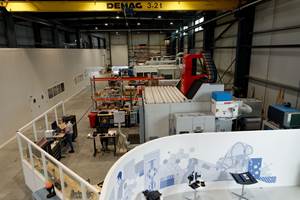Deep-sea shrimp inspiring ‘super-tough’ advanced composites
New research examined the exoskeleton of deep-sea shrimp exoskeleton that could have implications for the design of new synthetic armor capable of withstanding environmental extremes.
Share
Proof that nature itself can serve as the greatest inspiration for innovation, new research is revealing details about how the exoskeleton of a certain type of deep-sea shrimp could stimulate new material design for composites.
“A biological species surviving in that kind of extreme environment is a big deal,” said Vikas Tomar, an associate professor in Purdue University's School of Aeronautics and Astronautics. “And shrimp are a great test case for evolution because you can find different species all over the world living at various depths and with a range of adaptation requirements.”
Tomar and doctoral students Tao Qu, Devendra Verma, Yang Zhang and Chandra Prakash compared the exoskeletons of the deep-sea shrimp Rimicaris exoculata and the shallow-dwelling shrimp Pandalus platyceros. The deep-sea species lives 2,000 meters below the ocean surface in volcanic hydrothermal vents where temperatures can exceed 400 degrees Celsius, whereas the other species lives just below the ocean surface.
“We want to understand how evolution affects material behavior in the exoskeletons of these two shrimp species that thrive in far different conditions,” Tomar said.
Insights into the complex molecular behavior of the materials could have implications for the design of new synthetic armor capable of withstanding environmental extremes.
New findings were detailed in a research paper published online July 2 and will appear in a future print issue of the journal Acta Biomaterialia. Two other recent papers by the same researchers focused on laboratory experiments into the shrimp exoskeletons.
The researchers probed the interface between two key components of the exoskeletons: a protein called chitin and a bone-like mineral called calcite. How these two types of materials – one organic and the other inorganic – behave at their interface is critical to determining how the exoskeleton performs.
Ten exoskeleton specimens were studied, and experimental analyses were performed using laboratory techniques including scanning electron microscopy and electron diffraction spectroscopy, revealing details about the structure and chemical composition.
The exoskeletons of both species of shrimp possess the same microstructures: the chitin, calcite and other components are arranged in a layered helicoidal structure that resembles a spiral staircase. A comparison of the two species, however, showed differences in the density of the structures, thickness of the layers and mineral content. The deep-sea shrimp’s exoskeleton was found to possess a more densely packed structure.
To their surprise, the researchers found the exoskeleton of the surface shrimp is about 10 times stronger than the exoskeleton of the deep-sea shrimp.
“Mechanistically, you would expect that when it is compacted it becomes stronger, but it is actually weaker after compaction,” Tomar said.
The most recent research probed what happens at the interface between the chitin and calcite and how these mechanisms affect exoskeleton performance. This interface helps to determine how the structures transfer stress.
Findings showed the deep-sea exoskeleton is softer, yet capable of withstanding temperature and pressure extremes. The surface-shrimp exoskeleton is harder and better able to protect against predators.
“Even though they have the same basic microstructure, they are completely different materials,” Tomar said.
Information about the interface viscosity obtained using molecular simulations of the interacting materials allows for more accurate modeling of how polymer-ceramic composites deform due to strain. The researchers developed a “viscoplastic law,” or mathematical equations for such an interface.
Conventional models for polymer-ceramic composites fall short because they key on the peak strength, whereas the materials are more likely to fail by high strain, or being stretched.
“There are failure theories that we use, but they predict the failures in terms of strength,” Tomar said. “In the case of these materials it is the strain that’s most important, so you cannot exceed a certain level of deformation without breaking.”
Findings are shedding light on how water plays a vital role in providing strength to the molecular structure of the exoskeletons. The researchers also created an “interface database” to model how a particular composite material will perform given its composition, microstructure and type of interface.
Related Content
Hexagon Purus Westminster: Experience, growth, new developments in hydrogen storage
Hexagon Purus scales production of Type 4 composite tanks, discusses growth, recyclability, sensors and carbon fiber supply and sustainability.
Read MoreWatch: A practical view of sustainability in composites product development
Markus Beer of Forward Engineering addresses definitions of sustainability, how to approach sustainability goals, the role of life cycle analysis (LCA) and social, environmental and governmental driving forces. Watch his “CW Tech Days: Sustainability” presentation.
Read MoreNovel composite technology replaces welded joints in tubular structures
The Tree Composites TC-joint replaces traditional welding in jacket foundations for offshore wind turbine generator applications, advancing the world’s quest for fast, sustainable energy deployment.
Read MorePlant tour: Daher Shap’in TechCenter and composites production plant, Saint-Aignan-de-Grandlieu, France
Co-located R&D and production advance OOA thermosets, thermoplastics, welding, recycling and digital technologies for faster processing and certification of lighter, more sustainable composites.
Read MoreRead Next
Developing bonded composite repair for ships, offshore units
Bureau Veritas and industry partners issue guidelines and pave the way for certification via StrengthBond Offshore project.
Read MorePlant tour: Daher Shap’in TechCenter and composites production plant, Saint-Aignan-de-Grandlieu, France
Co-located R&D and production advance OOA thermosets, thermoplastics, welding, recycling and digital technologies for faster processing and certification of lighter, more sustainable composites.
Read MoreAll-recycled, needle-punched nonwoven CFRP slashes carbon footprint of Formula 2 seat
Dallara and Tenowo collaborate to produce a race-ready Formula 2 seat using recycled carbon fiber, reducing CO2 emissions by 97.5% compared to virgin materials.
Read More
























